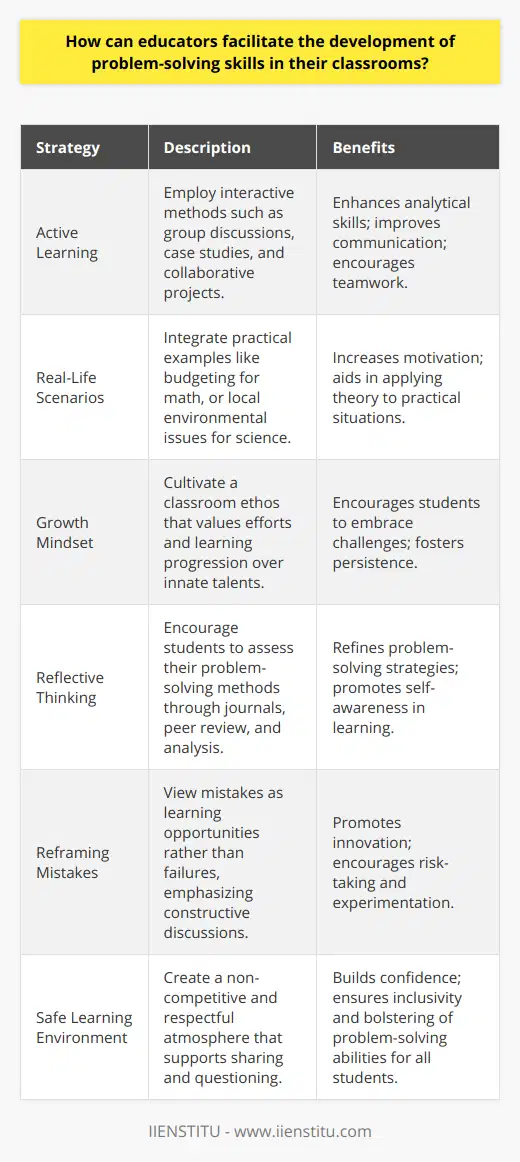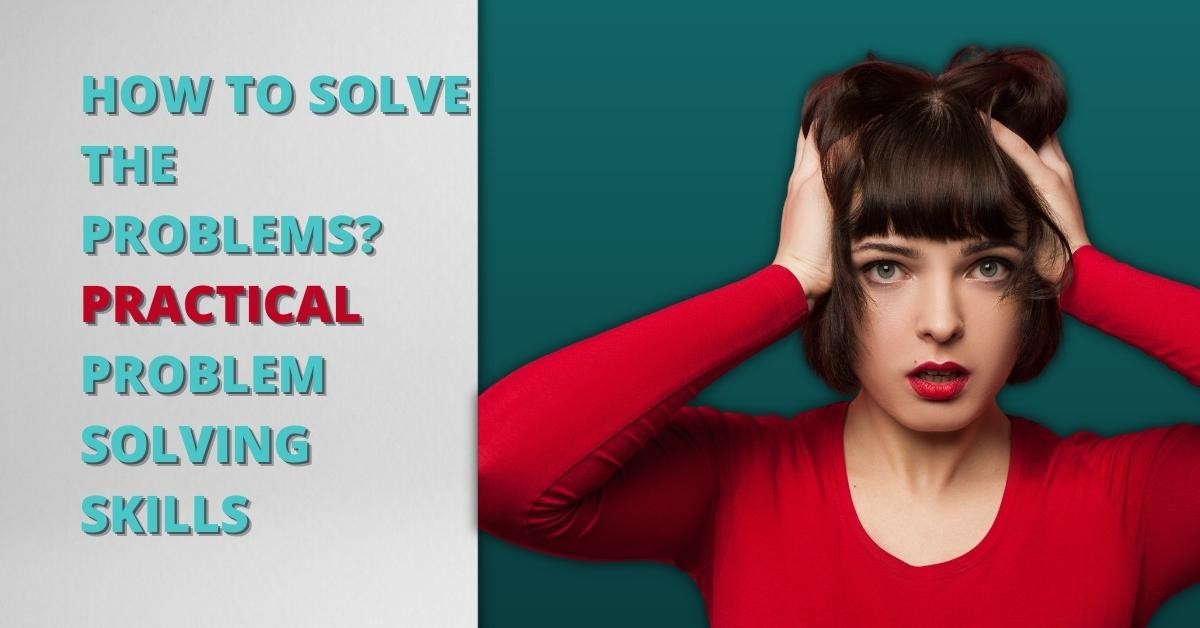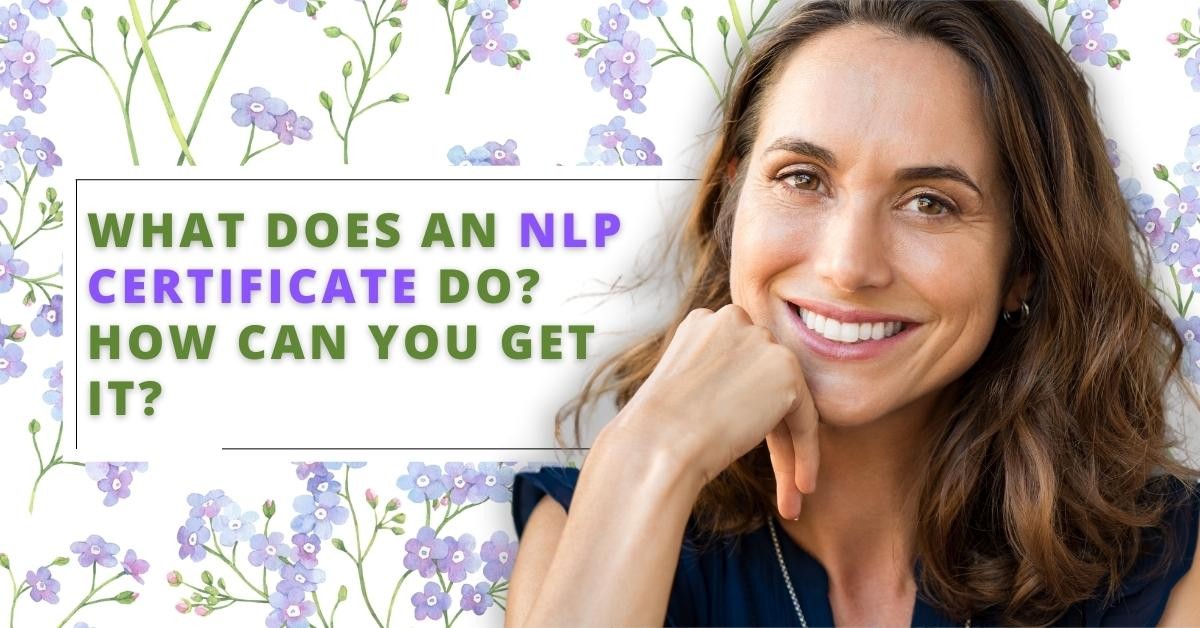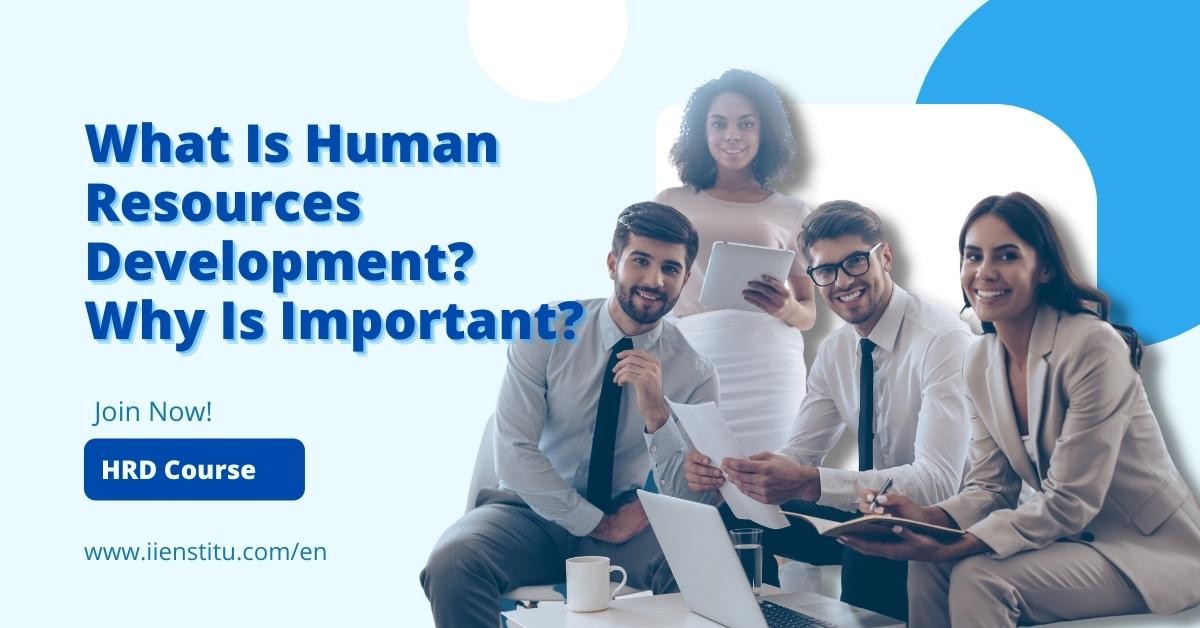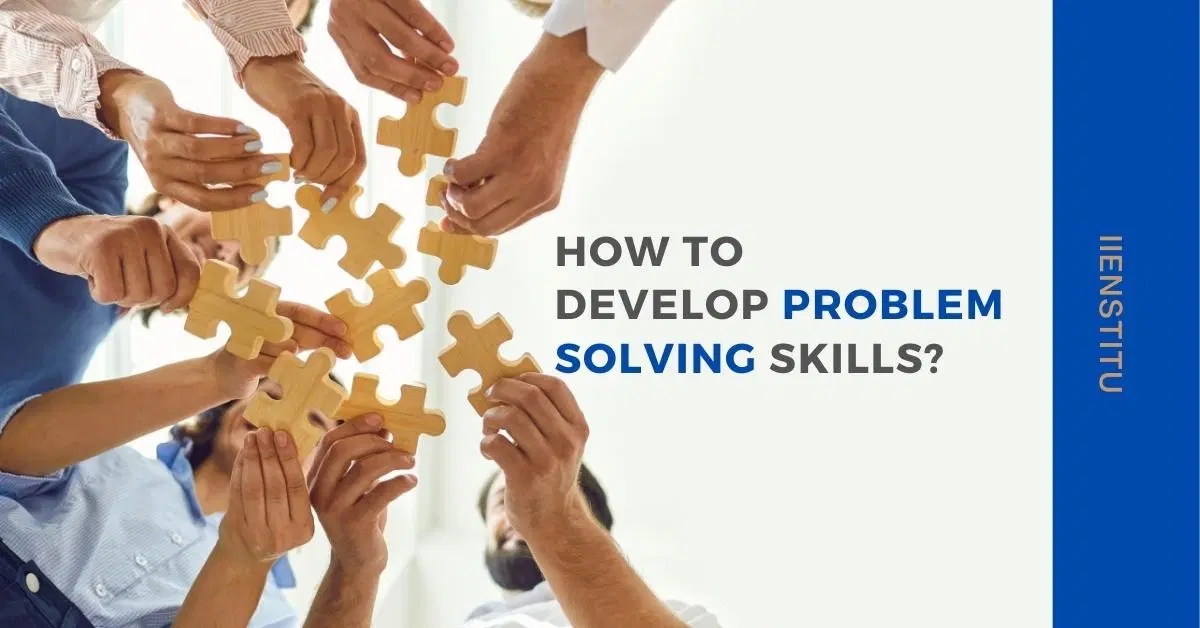
At times, it's easy to feel overwhelmed when we're faced with a daunting problem. I've certainly been there—staring at a challenge and thinking, "How on earth am I going to solve this?" But over the years, I've learned that patience and perseverance can turn that initial frustration into triumph. Developing effective problem-solving skills isn't about having all the answers right away; it's about approaching the issue methodically and keeping a positive mindset.
One of the best ways I've found to hone these skills is by following a structured approach. Here's a simple yet powerful strategy that has helped me, and it might just help you too:
1- First, identify the problem that needs to be solved
2- Next, brainstorm possible solutions and evaluate their effectiveness or feasibility
What is needed?
Why do they need it?
Where are they?
When are they doing it?
People generally don't like to buy things that solve problems that aren't problems, so be sure your users understand how significant the problem you're trying to solve is. If people think the problem isn't critical, they might not receive the solution to the problem.
3- Finally, choose a solution and take action on it!
Understanding the Problem
First, identify the problem that needs to be solved
I remember a time when I was working on a critical path method project management strategy for a client. The project was complex, and deadlines were tight. Everyone on the team was running around trying to fix issues as they popped up, but we weren't making any real progress. It was only when we paused for a moment and clearly defined what the actual problem was that we started to move forward.
What are the users' needs/goals/values?
How could these needs/goals/values be met?
What are the user's current solutions, and how could they be improved?
How much effort will it take for users to adopt the new resolution?
Is the problem worth solving?
It's crucial to get everyone on the same page. Sometimes the problem seems obvious, especially if it's something tangible like designing a new product. But other times, it's not so clear-cut. In those situations, asking the right questions can make all the difference:
What is needed?
Why is it needed?
Where is the issue occurring?
When does the problem arise?
By addressing these questions, you ensure that you're not just treating symptoms but actually tackling the root cause. After all, nobody wants to invest time and resources into solving the wrong problem!
Recognizing the Significance
People generally don't like to buy things that solve problems they don't perceive as problems. I once tried to pitch a new workflow solution to a team, but they didn't see the inefficiencies I was pointing out. It taught me that if people think the problem isn't critical, they might not embrace the solution. So, it's essential to understand how significant the problem is to those affected by it.
Now that you've identified the problem, it's time to think about what kind of solution will solve it best. You can do this by considering things like:
What are the users' needs, goals, and values?
How could these needs be met?
What are the users' current solutions, and how could they be improved?
How much effort will it take for users to adopt the new solution?
Is the problem worth solving?
The answers to these questions will help you develop a good solution that meets everyone's needs. Remember, the goal is to solve the problem, not just come up with an excellent new idea!
Generating Solutions
Next, brainstorm possible solutions and evaluate their effectiveness or feasibility
Once you've nailed down the problem, it's time for one of my favorite parts: brainstorming. I've always enjoyed this phase because it's where creativity meets practicality. Brainstorming is all about generating ideas without judgment. The goal is to come up with as many potential solutions as possible.
Whether you're working alone or in a group, here are some tips to make your brainstorming sessions more effective:
Keep an open mind
Encourage wild ideas
Build on the ideas of others
Avoid criticism during the idea-generation phase
Stay focused on the problem at hand
I recall a time when my team and I were facing a significant communication breakdown within our department. We gathered in a room and started tossing around ideas. Some suggestions were conventional, while others were out of left field, but that's the beauty of brainstorming! Eventually, we landed on a solution that improved our communication skills and effectiveness remarkably.
Evaluating Ideas
After generating a list of potential solutions, the next step is to evaluate each idea's feasibility and effectiveness. Consider factors such as:
1- Alignment with users' needs and values
2- Required resources and effort
3- Potential obstacles and risks
4- Long-term sustainability
5- Impact on other areas or processes
By carefully assessing each option, you can narrow down your choices and focus on the most promising solutions. This analysis skills exercise not only helps in making an informed decision but also enhances your critical thinking.
Taking Action
Finally, choose a solution and take action on it!
This is where the rubber meets the road. Selecting a solution can sometimes be daunting, but it's important to make a decision and move forward. I often remind myself of a saying my grandmother used to share: "You can't cross a chasm in two small jumps." In other words, commit to your chosen path and see it through.
Taking action might involve:
Developing a detailed implementation plan
Assigning tasks and responsibilities
Setting timelines and milestones
Monitoring progress and adjusting as needed
When I was working on improving our team's decision making process, we decided to implement a new software tool to streamline our workflow. It was a significant change, and there were some bumps along the way, but by taking decisive action and staying committed, we ultimately achieved better efficiency and collaboration.
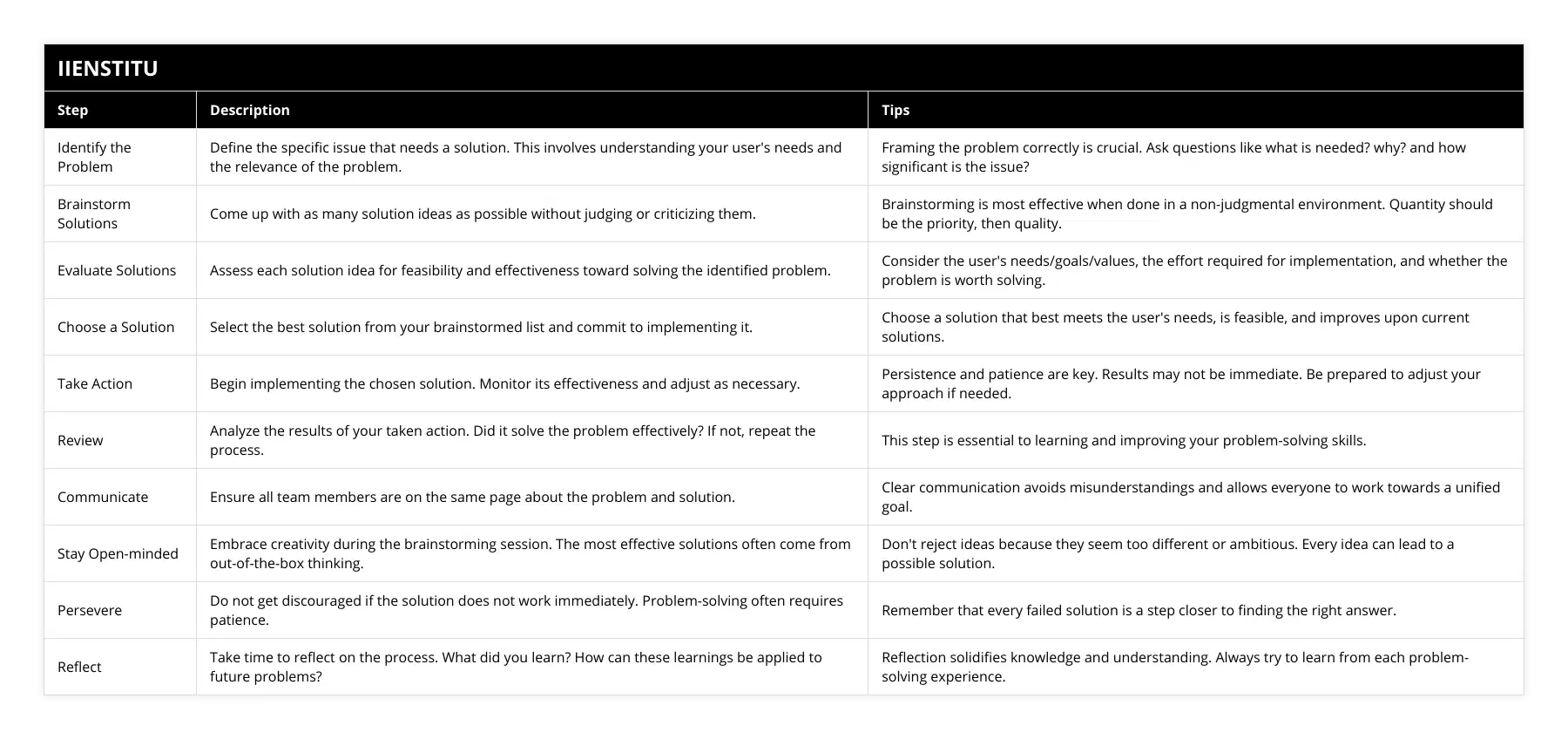
Reflecting on the Process
It's also essential to reflect on the outcome once you've implemented your solution. Ask yourself:
Did the solution effectively solve the problem?
What worked well, and what didn't?
What could be improved next time?
This reflection helps in your professional development and enhances your problem-solving and critical thinking skills for future challenges. It also improves your communication effectiveness when sharing insights with your team.
Personal Insights
I've found that sometimes, the solution isn't immediate, and that's okay. There have been moments when I've felt stuck, unsure of the next steps. In those times, taking a step back and allowing myself some space has been incredibly helpful.
Finding Your Spot to Relax and Solve a Problem
Everyone has their own way of unwinding and fostering creativity. For me, taking a walk in the park or sitting by the lake often brings clarity. There's something about the tranquility of nature that helps me think more clearly. What's your favorite spot to relax and solve a problem? Maybe it's a cozy corner in your home, a bustling café, or a quiet library.
Overcoming Time-Consuming Challenges
I remember the most time-consuming and difficult thing I ever solved was developing a comprehensive training program for new employees. It required integrating various departments, aligning on communication skills, and ensuring consistency across the board. It took months of hard work, but seeing the positive impact on new hires made it all worthwhile.
Moments of Triumph
Have you ever felt like you've outsmarted a complex issue or perhaps even someone? I had such a moment when I devised a solution that streamlined our workflow while reducing costs—something that many thought wasn't possible. It's those little victories that boost our confidence and motivate us to tackle even bigger challenges.
Solving Complex Mental or Emotional Challenges
If solving a complex mental or emotional challenge was possible, what would it take to do so effectively for ourselves and others? I believe it requires:
Self-awareness
Empathy
Effective communication skills
Patience and persistence
Willingness to seek help
Understanding ourselves and others is key. By fostering open dialogues, practicing active listening, and being willing to seek help when needed, we can navigate these intricate challenges more effectively.
The Importance of Life Skills
Developing problem-solving skills isn't just about tackling work-related issues; it's a vital life skill. Whether it's making personal decisions, planning for the future, or helping friends and family, the ability to think critically and act decisively is invaluable.
Next Steps in Your Problem-Solving Journey
So, where do you go from here? Define the skills you want to improve upon. Is it enhancing your analysis skills, boosting your communication effectiveness, or perhaps learning new decision-making strategies? Setting clear goals will help you focus your efforts and measure your progress.
Consider these next steps:
1- Reflect on recent challenges you've faced and how you approached them
2- Identify areas where you felt stuck and why
3- Seek out resources, such as workshops or books, to build your skills
4- Practice mindfulness to enhance your critical thinking
5- Engage with mentors or peers for feedback and support
Conclusion
Solving problems, whether big or small, is an integral part of our lives. It can be tough at times, and we might feel like the solution is out of reach. But by following a structured approach, staying patient, and persevering, we can overcome obstacles and achieve our goals.
Remember, every problem is an opportunity to learn and grow. So the next time you're faced with a challenge, take a deep breath, trust in your abilities, and start working through the steps. You've got this!
References
Smith, J. (2018). The Art of Critical Thinking. New York: HarperCollins.
Johnson, L. (2020). Effective Communication Skills for Professionals. London: Penguin Books.
Davis, M. (2017). Mastering Decision Making. Boston: McGraw-Hill.
Frequently Asked Questions
How to develop problem solving skills?
If you want to become an expert in problem solving skills, keep in mind that it takes time and effort to develop any expertise or mindful concentrative discipline.

How to identify the problem?
The first step is to take the system apart, find the root cause of the problem, and fix.
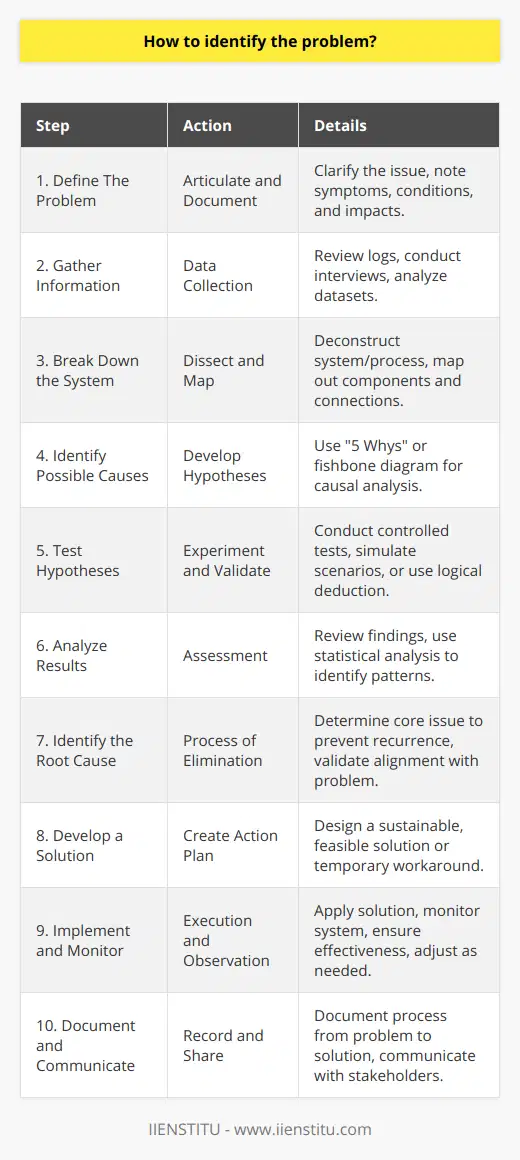
How to apply problem solving techniques?
You should always start with the question you are trying to answer and work backwards from it. For example, if you wanted to know how much laundry detergent would be needed for a load of sheets and towels, and your estimated load is 10 lbs, then your problem would be 10 lbs x 1/2 oz x 2 = 5 ounces of detergent.
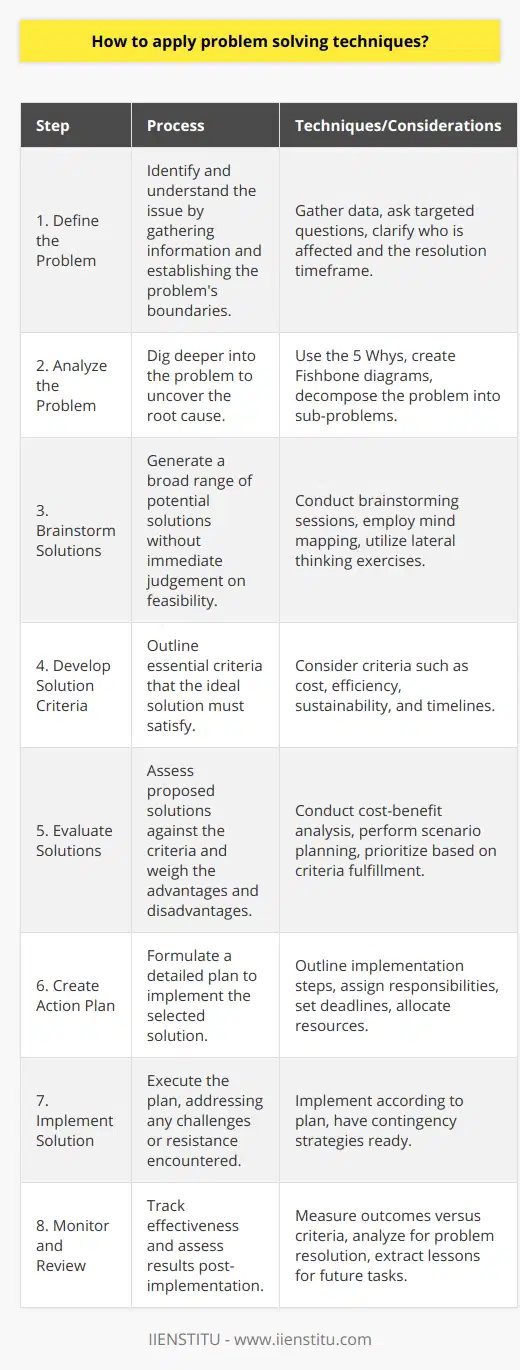
What are the five ways of developing problem-solving skills?
**Understanding the Problem**
One crucial approach to developing problem-solving skills is understanding the problem itself. By comprehending the problem's nature, the desired outcome, and the possible obstacles, individuals set the stage for finding practical solutions.
**Generating Alternatives**
The second method involves generating multiple alternatives for solving the problem. Brainstorming various options allows for a comprehensive examination of the situation, from which the most effective and efficient solution can be chosen.
**Evaluating Alternatives**
In the third stage, individuals assess the generated alternatives by considering the pros and cons of each option. Weighing the benefits and drawbacks of different solutions encourages critical thinking and helps determine the most appropriate course of action.
**Implementing the Solution**
The fourth step is implementing the chosen solution. This stage requires individuals to apply their decision-making, planning, and organizational skills to put the selected approach into practice. Active participation and persistence are key factors in successful problem-solving.
**Monitoring and Adjusting**
Finally, the fifth method involves monitoring the progress of the chosen solution and adjusting it as needed. An effective problem-solver maintains flexibility and is willing to adapt their approach when necessary, continually evaluating their strategies and making changes when required.
In summary, developing problem-solving skills involves understanding the problem, generating and evaluating alternatives, implementing the chosen solution, and monitoring the progress and adjusting as needed. By cultivating these skills, individuals become better-equipped to navigate the complexities of life, both personally and professionally.
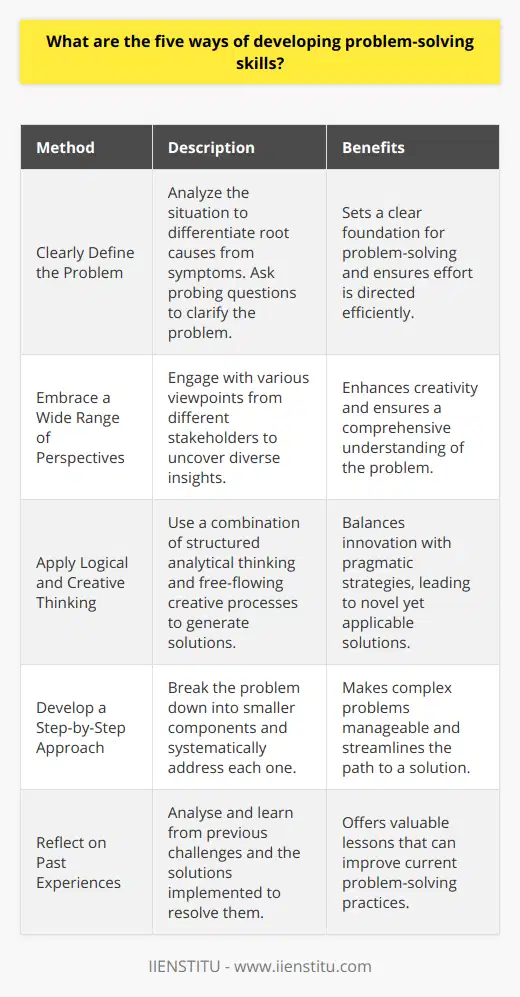
Is it possible to develop problem-solving skills?
**Developing Problem-Solving Skills**
Absolutely, it is possible to develop problem-solving skills. These skills are considered to be cognitive processes that can be enhanced through targeted training and practice. Various approaches can be employed to develop and improve these essential abilities.
**Cognitive Approaches**
One method for cultivating problem-solving skills is through cognitive approaches, which involve the use of mental techniques and strategies. These may consist of analytical reasoning, critical thinking, and creative problem-solving, among others. Practicing these methods regularly can lead to better problem-solving abilities over time.
**Skill-Based Training**
Skill-based training is another approach to enhance problem-solving skills. This type of training focuses on teaching specific strategies and techniques that can be applied to a wide range of problems. These may include decision-making processes, communication skills, and collaborative techniques. Through skill-based training, individuals can acquire the tools necessary for effective problem-solving.
**Experiential Learning**
Experiential learning involves gaining problem-solving skills by engaging in hands-on experiences and real-world situations. This approach allows individuals to develop their abilities by working through actual problems and reflecting on their experiences. By participating in experiential learning, individuals become more adept at identifying and addressing various problems.
**Educational Programs**
Problem-solving skills can also be developed through specific educational programs designed to foster critical thinking and analysis. These programs often incorporate a combination of cognitive approaches, skill-based training, and experiential learning to create a comprehensive curriculum aimed at cultivating problem-solving abilities.
**Continuous Learning and Practice**
Finally, continuous learning and practice are essential for maintaining and improving problem-solving skills. By constantly striving to learn new strategies and techniques, individuals can adapt their problem-solving abilities to the ever-changing landscape of challenges they may encounter throughout their lives. Regular practice also helps to reinforce these skills and strengthen their applicability across diverse situations.
In conclusion, the development of problem-solving skills is an achievable goal through a combination of cognitive approaches, skill-based training, experiential learning, and educational programs. With continuous learning and practice, individuals can cultivate these skills, allowing them to successfully navigate the myriad of challenges they may face in their personal and professional lives.
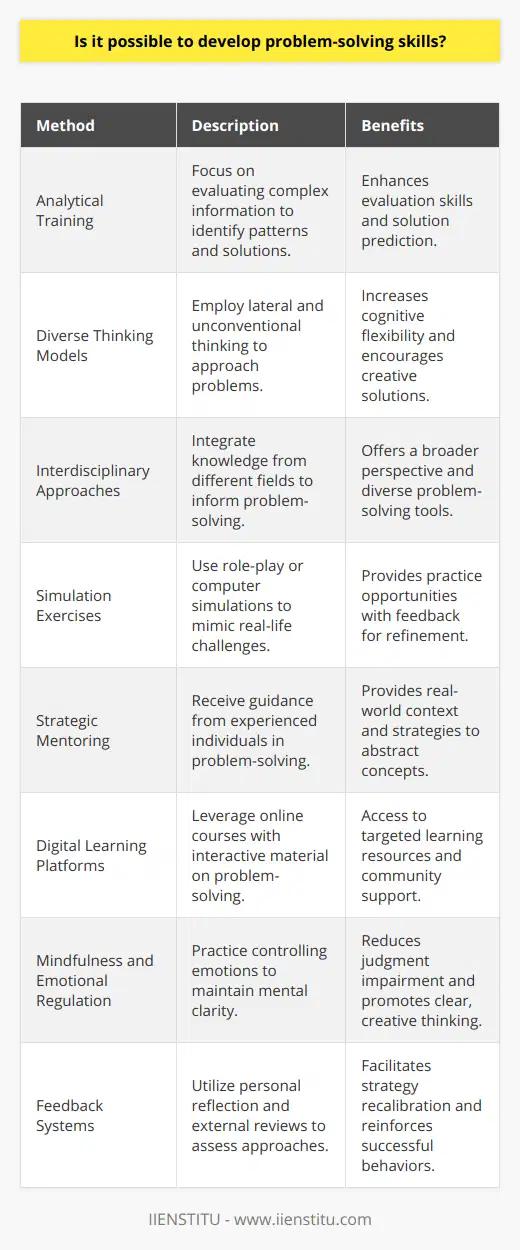
What are the 7 steps to problem-solving skills?
Identify the Problem
The first step in problem-solving is identifying the problem, which involves clearly understanding the underlying issue and its significance.
Gather Information
Next, gather relevant information about the problem by researching, observing, and asking questions. This allows individuals to gain a well-rounded understanding of the situation.
Develop Potential Solutions
Once the problem and supporting information are understood, brainstorm multiple potential solutions. Consider a variety of approaches to find the most effective and feasible course of action.
Analyze Options
In the fourth step, analyze the advantages and disadvantages of each potential solution. Determine which options are most likely to succeed by evaluating the costs, benefits, and potential impacts.
Select the Best Solution
Upon comparing different options, choose the best solution that is most likely to solve the problem. It is important to consider the feasibility and potential consequences when making a decision.
Implement the Solution
Put the chosen solution into action by developing a detailed plan, allocating resources, and assigning responsibilities to team members. Monitor progress and make adjustments as necessary.
Evaluate Effectiveness
Conclusively, evaluate the effectiveness of the implemented solution by comparing the results to the original problem. This will determine if the problem was successfully resolved or if further intervention is needed.
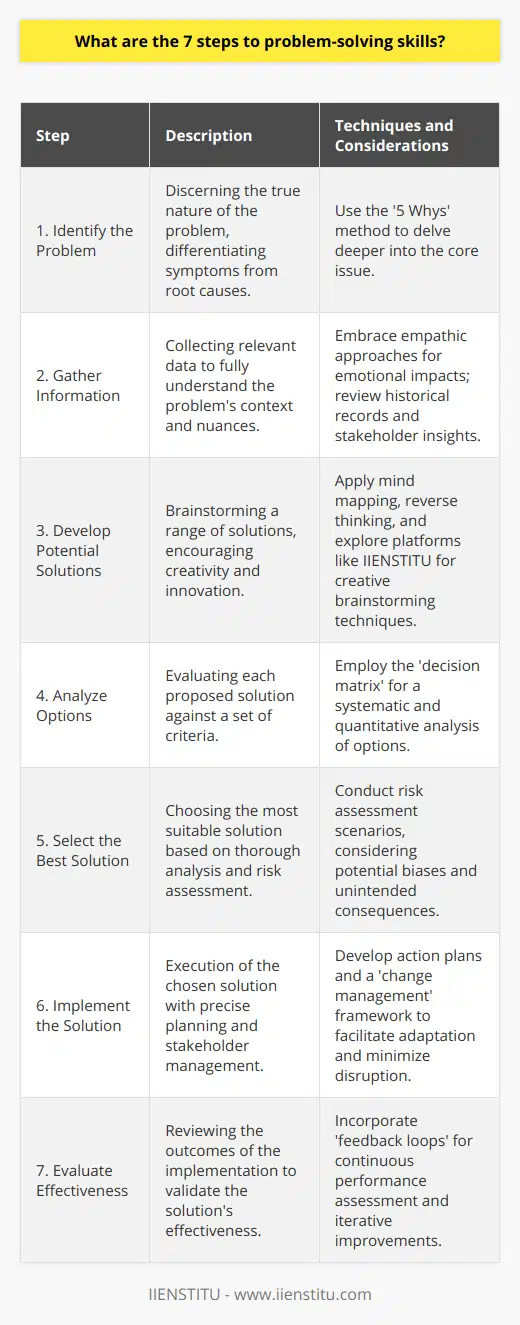
How do students develop problem-solving skills?
Development of Problem-Solving Skills
Students develop problem-solving skills through various methods. Let's explore these ways below:
Effect of Classroom Activities
Classroom activities promote problem-solving skills. Teachers engage students in group conflict scenarios and role-play exercises. These activities enhance critical thinking, logic, and decision-making abilities.
Impact of Curricular Tasks
Curriculum-based tasks, like projects or research assignments, also significantly contribute. Students must manage time, resources, and work through complex information. This prompts the use of problem-solving capabilities.
Role of Individual Studies
Individual study and homework assignments also stimulate these skills. Students must tackle tasks alone, navigating potential challenges and finding solutions independently.
Significance of Extracurricular Activities
Extracurricular activities, like sports or clubs, instill problem-solving skills too. Students overcome hurdles, strategize, and make quick decisions during these activities.
Involvement in Decision Making
Schools may include students in certain decision-making processes. This active participation helps them understand problem analysis and effective decision-making in real-life situations.
Technological Integration
Technology use in learning can foster these skills. Digital tools often require students to troubleshoot or figure out functions, enhancing their problem-solving skills.
Examining these methods, it's clear that a multitude of factors at school aid students in developing problem-solving prowess. This all-around nurturing within the school environment has a profound, long-lasting impact on shaping students' abilities.
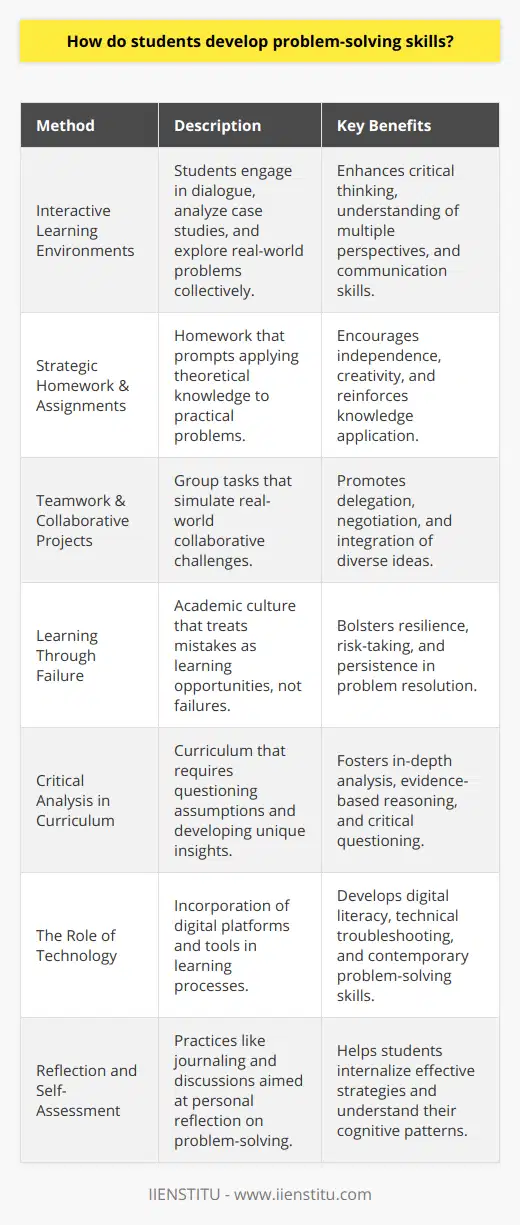
What are the key components of an effective problem-solving process?
Identifying the Problem
A crucial first step in a problem-solving process is accurately identifying the problem. Without correctly recognizing the issue, finding an effective solution becomes challenging.
Defining the Goals
Once we understand the issue, defining the desired objectives helps to form the context for the solutions. Clear objectives guide the problem-solving efforts and assist in evaluating the success of the solution.
Brainstorming Solutions
Brainstorming potential solutions allows for the exploration of various approaches to the problem. This step encourages thinking outside the box and coming up with innovative solutions.
Analyzing Solutions
The evaluation of proposed solutions forms the next step. Each solution needs to undergo a thorough analysis to identify its feasibility and potential effectiveness.
Creating an Action Plan
Once we find the most suitable solution, creating an actionable plan aids in the practical application of the solution. This plan should detail the steps necessary to execute the chosen solution.
Implementing the Solution
The next step is implementing the chosen solution according to the action plan. Thoughtful execution is critical at this stage to ensure that the intended outcomes are achieved.
Reviewing the Process
Finally, the problem-solving process concludes with a review of the overall process and results. This reviewing step enables learning from the proceeding and adapting future problem-solving processes accordingly.
Effectively managing each of these elements embraces a strategic approach to tackling problems, which often leads to sustainable solutions. It enables an organization to take on challenges with confidence and clarity and fosters a problem-solving mindset throughout the organization.
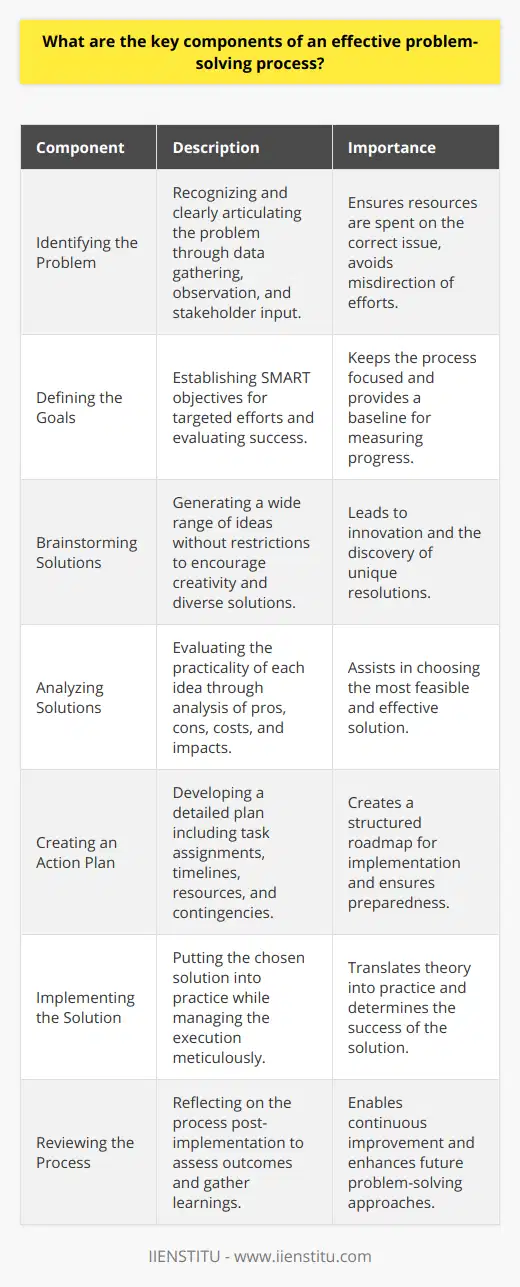
How can educators facilitate the development of problem-solving skills in their classrooms?
Promoting Active Learning Strategies
Educators can facilitate problem-solving skills by promoting active learning strategies. Active learning nurtures critical thinking and enables students to comprehend difficult concepts easier. Techniques like group discussions, case studies, and collaborative projects empower students to reason, analyze, and solve problems collectively.
Incorporating Real-Life Scenarios
Teachers can incorporate real-life scenarios into lessons. By attaching problems to real-world contexts, students grasp the relevance of their learning. This approach facilitates transfer of knowledge, making it easier for students to apply their problem-solving skills beyond the classroom.
Fostering a Growth Mindset
Fostering a growth mindset is significant for the development of problem-solving skills. By encouraging students to believe in their potential to learn, educators foster resilience in solving challenging problems. Positive reinforcement is key to cultivating this mindset.
Encouraging Reflective Thinking
Encouraging reflective thinking can enhance problem-solving abilities. By inviting students to examine the outcomes of their decisions critically, it cultivates a more deliberate and thoughtful problem-solving approach.
Reframing Mistakes as Opportunities
Educators can reframe mistakes not as failures but as opportunities for learning. The acceptance of error as part of the learning process can help students to persevere, fostering the resilience needed for effective problem-solving.
Creating a Safe Learning Environment
Finally, creating a safe, respectful, and inclusive learning environment is crucial. This atmosphere encourages students to share ideas, receive feedback, and continue refining their problem-solving abilities without the fear of criticism or judgment.
In conclusion, through active learning, real-world application, mindset training, reflective thinking, reframing mistakes, and creating safe environments, educators can effectively nurture problem-solving skills in their students. These strategies can significantly enhance the students’ abilities to understand, analyze, and resolve a wide array of problems.
